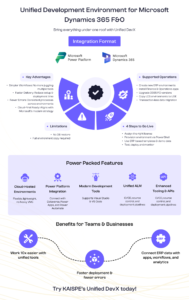With the world of Microsoft 365 Dynamics rapidly evolving and growing, developers often juggle with multiple technical stuff, tools, environment and various processes just to get the right work done.
With the rising complexities, sometimes keeping a track of each tool or environment can be pretty tough, especially when you have so much on your business plate.
Just to ease the developer’s work, Microsoft has introduced a Unified Development Experience for finance and operations. The main initiative of this framework is to modernize and simplify day to day developments by bringing all the essential tools, environment and best practices under a single umbrella.
So, if you are casually exploring the mighty D365 FO capabilities or planning your next deployment move, then understanding the essentials of Unified Development Environment is totally worth it.
What is the Unified Development Experience?
The Unified Development Experience for Finance and Operations apps (Unified DevX) is an initiative to streamline and modernize the development environment for Dynamics 365 Finance and Operations (D365 FO) by aligning it more closely with the broader Power Platform and Azure DevOps ecosystem.
The main purpose is to bring together all the tools, environments, and best practices a developer needs to build, debug, and deploy customizations or extensions for D365 FO in a consistent and integrated way.
In a simple way, Microsoft has introduced the Unified Development Experience for juggling developers so they can have everything in a unified place.
Why Unified Development Environment Matters for Developers and Businesses?
With the Unified Development Environment developers can make their work 10x easier, they don’t even have to wait longer or switch between the systems or even setting up with the heavy local VMs. Businesses can easily gain faster delivery cycles, fewer errors, and stronger alignment with Microsoft’s cloud-first strategy.
You don’t need to do everything all together, let Unified DevX handle your tasks.
The Power Platform integration with Dynamics 365 also opens various possibilities which makes it easier to connect ERP data to low-code apps, automated workflows, and advanced analytics without complex integrations.
Key Features of Unified Development Environments
The Unified DevX for D365 FO is entirely reshaping the way teams approach Dynamics 365 Finance and Operations development. The following key features of UDE sets is apart from others:
Cloud-Hosted Development Environments
Developers can now leverage cloud-hosted environments managed via the Power Platform Admin Center, moving away from the traditional on-premises or Azure-hosted VMs. This shift offers better scalability and reduces local resource consumption.
Power Platform Integration
UDE bridges F&O with the Power Platform, allowing developers to build extensions that interact seamlessly with Dataverse, Power Apps, and Power Automate. This integration supports both low-code/no-code and pro-code development paradigms.
Modern Development Tools
While Visual Studio remains central for F&O development, Microsoft is enhancing support for Visual Studio Code (VS Code), enabling lighter-weight development and potential cross-platform capabilities in the future.
Unified Application Lifecycle Management (ALM)
With UDE, developers can utilize Azure DevOps for source control, continuous integration, and deployment pipelines, promoting best practices and ensuring code quality across environments.
Enhanced Tooling and APIs
Microsoft provides improved tooling, including command-line interfaces and API wrappers, to automate deployment and management tasks. Telemetry and diagnostics across environments are also more robust, aiding in monitoring and troubleshooting.
Configurations
First you must have an appropriate license assigned to your user to provision the environment. An example license is Dynamics 365 Finance or Dynamics 365 Supply Chain Management for customers, and Dynamics 365 Operations Application Partner Sandbox for partners and ISVs. The following table shows the mapping between various finance and operations apps licenses and their template details.

Explore the Unified Development Experience for Finance and Operations by KAISPE today and streamline your daily dev operations.
You must have at least 1 gigabyte of available Operations and Dataverse database capacities as per documentation but an environment provision with Demo data consumes somewhat around 5 GB of data verse and 6 GB of FinOps capacities.
How to Provision an Environment ( Step by Step)
Microsoft makes provisioning easy and clear using PowerShell. Here’s the simplified flow:
Open your PowerShell console application, and run the following commands to generate the environment.
#Install the module
Install-Module -Name Microsoft.PowerApps.Administration.PowerShell
Write-Host “Creating a session against the Power Platform API”
Add-PowerAppsAccount -Endpoint prod
#To construct the json object to pass in
$jsonObject= @”
{
“PostProvisioningPackages”:
[
{
“applicationUniqueName”: “msdyn_FinanceAndOperationsProvisioningAppAnchor”,
“parameters”: “DevToolsEnabled=true|DemoDataEnabled=true”
}
]
}
“@ | ConvertFrom-Json
# To kick off new environment Provisionment
# IMPORTANT – This has to be a single line, after the copy & paste the command
New-AdminPowerAppEnvironment -DisplayName “MyUniqueNameHere” -EnvironmentSku
Sandbox -Templates “D365_FinOps_Finance” -TemplateMetadata $jsonObject –
LocationName “Canada” -ProvisionDatabase
Now, similarly you can delete the environment with below command.
#Remove the previously created environment by ID
Remove-AdminPowerAppEnvironment -EnvironmentName [Guid]
Currently Supported Operations
For now, here’s what Unified Development Environment supports:
- Provision a new environment with an ERP-based template
- Install the Finance and Operations Provisioning app
- Update the Finance and Operations(version Upgrade)
- Copy a LCS environment to a unified environment(Production data to UDE )
- Perform a transaction-less copy between environments( to reduce overall size and then selected number of transactions could be imported via data management framework
Unified Development Environment Limitations
Here are few limitations to keep in mind:
- DB restore in not available
- You need to copy the full environment
Conclusion
To sum it up, the Unified Development Environment for Finance and Operations is a strategic shift towards cloud-first, integrated, and scalable development. You can get:
- One workspace for all dynamics 365 F&O development tasks
- Cloud hosted environments for faster setups
- Power Platform integrations for connected apps and automation
- Support VS and Visual Code
- Azure DevOps for source control and deployments
- Appropriate licensing is needed and a few limitations apply




